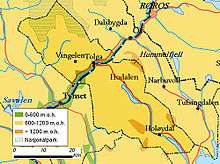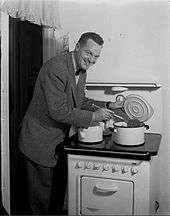Braathens SAFE Flight 253
| Accident summary | |
|---|---|
| Date | 7 November 1956 |
| Site |
Hummelfjell 62°24′14″N 11°16′52″E / 62.404°N 11.281°ECoordinates: 62°24′14″N 11°16′52″E / 62.404°N 11.281°E |
| Passengers | 10 |
| Crew | 2 |
| Fatalities | 2 |
| Survivors | 10 |
| Aircraft type | de Havilland DH-114 Heron 2B |
| Aircraft name | Lars |
| Operator | Braathens SAFE |
| Registration | LN-SUR |
| Flight origin | Trondheim Airport, Værnes |
| Destination | Oslo Airport, Fornebu |
Braathens SAFE Flight 253, also known as the Hummelfjell Accident (Norwegian: Hummelfjell-ulykken), occurred on 7 November 1956 at 9:50, when a de Havilland Heron crashed into the mountain Hummelfjell in Tolga, Norway. The Braathens SAFE aircraft was en route from Trondheim Airport, Værnes to Oslo Airport, Fornebu. While passing Røros the Heron started experiencing a rapidly accelerating atmospheric icing which soon was too extensive for the ice protection system to handle. Combined with downdraft, the aircraft lost sufficient lift to stay airborne. The pilots were able to turn around the aircraft, but it hit Hummelfjell at an altitude of 1,350 meters (4,430 ft) above mean sea level.
The aircraft's captain was killed in the impact and a passenger died shortly afterwards. Ten people survived the crash, which was the first fatal accident of Braathens SAFE. Amongst the survivors was Rolf Kirkvaag, at the time Norway's most popular radio host. The search and rescue operation was severely hindered by a blizzard and poor visibility. Kirkvaag and another person left the plane after a day and met a rescue party. The investigation concluded that there were neither technical faults with the aircraft nor pilot error, and that it was not possible to predict the weather conditions which caused the icing.
Flight

The accident aircraft was a de Havilland DH-114 Heron 2B with registration LN-SUR, serial number 14093 and named Lars. It was bought new by Braathens SAFE and was registered on 8 February 1956.[1] The Herons had been introduced in Braathens SAFE's fleet in 1952 and remained in service until 1960.[2] Lars was insured by Lloyd's.[3]
Flight 253 was a scheduled morning service from Trondheim Airport, Værnes to Oslo Airport, Fornebu, with a nominal flight time of one and a half hours.[4] It had a flight crew of two and ten passengers.[5] Among the passengers was Rolf Kirkvaag, a radio host and journalist for the Norwegian Broadcasting Corporation. He was at the time the channel's most popular hosts, specializing in quiz programs. He has been described as Norway's first national celebrity.[6]
The flight departed Værnes at 8:30. It climbed to a cruising altitude of 2,500 meters (8,000 ft) and passed Tolga Radio Beacon at 09:12. In the area around Røros the aircraft started experiencing icing, which quickly rose to levels which could not be handled by the ice protection system. In addition, the aircraft was subject to a downdraft. The pilots therefore chose to turn the aircraft around and return to Trondheim. However, the icing was so aggressive that the aircraft continued to lose elevation.[7] It was flying through a blizzard and there was poor sight, making navigation difficult.[8]
In addition to influencing the lift, the icing covered the windshield and the radio antenna, causing radio communication to be cut.[9] The pilot was therefore not able to navigate properly and was not aware of that he was flying over the mountain.[8] The aircraft hit the mountain of Hummelfjell at 09:50—at an altitude of 1,350 meters (4,430 ft)[7]—in the municipality of Tolga.[10] The aircraft had a speed of 300 kilometers per hour (160 kn) at the time of impact, hitting the ground with the tail first. The engines broke off and the aircraft slid along the snow dune.[4] The aircraft bounced once before settling in a snow dune, which severely limited the impact and presumably saved the lives of many of the passengers.[10]
Rescue
Ten people survived the crash, with the captain and a passenger being killed. The latter died after the accident of heart problems directly related to the stress of the incident. The accident occurred in an isolated area, with bad weather and inaccessibility for search and rescue troops.[5] The passengers stayed at the aircraft for a day, waiting to be rescued. Kirkvaag was aware of the dangers of the injured and frozen passengers if they should fall asleep.[10] They introduced a roll-call every ten minutes and Kirkvaag improvised a radio program to keep up the spirits.[11] The accident and rescue operations generated a large media interest and especially the radio was a popular media to follow the development of the situation. This was intensified with a celebrity being amongst the passengers.[4]

The rescue site was covered in snowfall and fog, making the search and rescue operation very difficult. The visibility was so poor that the searchers would have to walk straight on the aircraft if they were to find it. It was estimated that there was about 20 meters (66 ft) of visibility at the site. Searches with aircraft were carried out, but futile as they would not be able to see the wreckage.[12] More critical was that the authorities at first did not know the location of the crash site. Initially all that was known was that it was located somewhere between Trondheim and Oslo, probably in Østerdalen somewhere. Later there came reports from the area around Hummelfjell that people had heard a great crash and the search was concentrated around that area.[4]
The search was led by Police Inspector Oppegård. On 8 November a team of twenty-eight people started search for the aircraft in the Hummelfjell area, based on the observations of a large sound. They set up a base of operations at the farm at Brend, who were able to feed and house the entire group of military and volunteer personnel. They had two M29 Weasel belted vehicles, but these could not be used. A search area of 10 by 20 kilometers (6.2 by 12.4 mi) was designated between Gråhøgda and Grøtvolen. Simultaneously a group of Home Guard personnel were sent around to the other side of the mountain, to climb and search it from the Atna side.[12]
After spending about twenty-four hours at the accident site, and without any sign of the blizzard dying down, Kirkvaag—who had two fractures in his leg—and another passenger chose to go for help. Lacking skis, they were forced to walk through the deep snow.[11] Kirkevaag later stated that he had left in a state of panic, not wanting to die at the crash site. They soon found a river bed which they followed in the hopes of finding someone.[4] Visibility remained poor, at about 20 meters (66 ft). However, the duo stumbled upon a two skiers from Hodalen, which were tracking them. Kirkvaag later commented that he was so confused that he thought he was out skiing and that the two wanted to pass, so he stepped aside.[11] They were able to alert the coordinators and first rescue crew arrived at the site at 12:30, twenty-seven hours had passed since the accident. However, it took hours before the crew were rescued and several were carried down on stretchers made from parts of the aircraft.[4]
Investigation
.jpg)
A commission was appointed to investigate the accident.[13] Representatives from the Royal Norwegian Air Force and de Havilland inspected the wreckage on 11 November, concluding that the aircraft was a write-off. That day there was a large stream of people who came to have a look at the accident site. By then all personal properties had been removed.[3] Parts from the plane were afterwards used to rebuild another two Herons: LN-NPI, after it was damaged on 26 January 1957, and LN-SUL.[1] The commission published a preliminary investigation report on 20 November and the final report was published on 9 May 1957 and had the same conclusions.[13]
The commission rejected that the aircraft did not have a sufficiently potent ice protection system, stating that the Heron's were equipped with a better system than comparable aircraft. It was of the opinion that no contemporary ice protections systems would have been capable of de-icing the aircraft in the conditions.[13] They found no faults with the pilot's actions.[8] It also recommended that airlines equip aircraft with additional first-aid and survival equipment.[13]
The commission found that the aircraft was subject to so much icing that even if it had steered clear of Hummelfjell it would still have been forced to land or crash within short time. The icing happened extremely rapidly and the commission found that the pilots' choice to turn around the aircraft could not have happened earlier. It stated that the weather data which the pilots received at Værnes did not predict the conditions which led to the icing. However, it found that had the pilots conferenced in person with a meteorologist concerning the weather along the whole route the conditions may have been discovered in advance, and recommended that such procedures developed.[8]
Flight 253 was the third write-off of a Heron and the second fatal accident with the type.[14] The accident was Braathens SAFE's first fatal accident.[5] Along with Flight 239 in 1972, which killed 40 people, they would be the only fatal accidents in the airline's history.[15] There has been erected a memorial at the crash site.[11]
References
- 1 2 Hagby: 294
- ↑ Tjomsland and Wilsberg: 64–65
- 1 2 "Flyet kan ikke berges: Instrumentene også ødelagt". Verdens Gang (in Norwegian). 12 November 1956. p. 10.
- 1 2 3 4 5 6 Vespestad, Linda (12 October 2013). "Berget livet med hjelp fra "Sjonkel Rolf"" (in Norwegian). Archived from the original on 15 April 2014. Retrieved 15 April 2014.
- 1 2 3 Tjomsland and Wilsberg: 111
- ↑ Johansen, Per Kristian (2 November 2004). "Rolf Kirkvaag – Norges første kjendis" (in Norwegian). Archived from the original on 26 March 2014. Retrieved 15 April 2014.
- 1 2 "Wednesday 7 November 1956". Aviation Safety Network. Retrieved 14 April 2014.
- 1 2 3 4 "Rapporten om flyulykken på Hommelfjell: Usedvanlig sterk nedising årsaken Mannskapet gjorde ingen feil". Verdens Gang (in Norwegian). 27 November 1956. p. 10.
- ↑ "Desperat situasjon for flygerne". Verdens Gang (in Norwegian). 9 November 1956. p. 1.
- 1 2 3 Børresen, Mette Finborud; Elgåen, Joar (3 November 2006). "Heltene i flystyrten" (in Norwegian). Archived from the original on 15 April 2014. Retrieved 15 April 2014.
- 1 2 3 4 Lilleeng, Sverre; Slåen, Geir Olav (7 November 2011). "Her blei Sjonkel Rolf en folkehelt" (in Norwegian). Archived from the original on 15 April 2014. Retrieved 15 April 2014.
- 1 2 Ottesen, Rolf (8 November 1956). "Forrykende vær på fjellet letingen begynte grytidlig". Verdens Gang (in Norwegian). p. 6.
- 1 2 3 4 "Heron-flyene har gode anvisnings-anlegg [sic]". Verdens Gang (in Norwegian). 10 May 1957. p. 12.
- ↑ "de Havilland DH-114 Heron". Aviation Safety Network. Retrieved 15 April 2014.
- ↑ "Braathens SAFE". Aviation Safety Network. Retrieved 14 April 2014.
Bibliography
- Hagby, Kay (1998). Fra Nielsen & Winther til Boeing 747 (in Norwegian). Drammen: Hagby.
- Tjomsland, Audun; Wilsberg, Kjell (1996). Braathens SAFE 50 år: Mot alle odds (in Norwegian). Oslo. ISBN 82-990400-1-9.